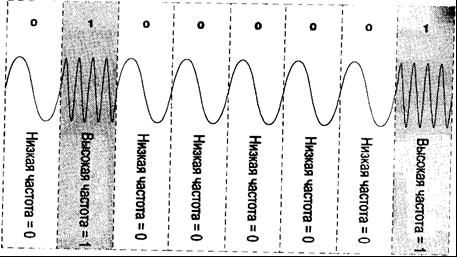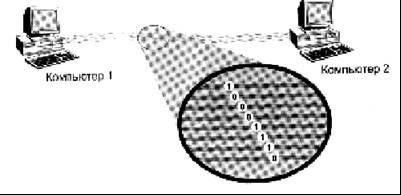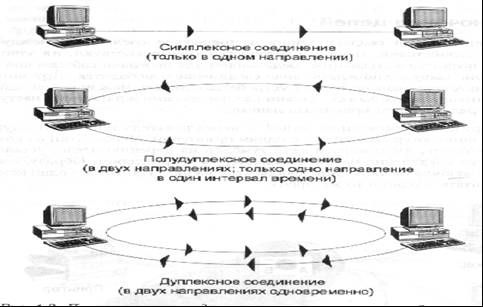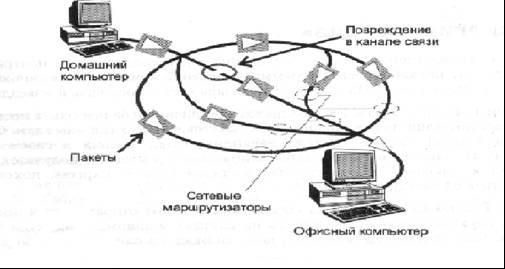Physical data transmission over communication lines
Communication line generally consists of a physical medium through which electrical information signals are transmitted, data transmission equipment and intermediate equipment. Synonymous with the term communication line(line) is a term link(channel).
The physical transmission medium can be a cable, that is, a set of wires, insulating and protective sheaths and connectors, as well as the earth's atmosphere or outer space through which electromagnetic waves propagate.
Depending on the data transmission medium, communication lines are divided into the following:
§ wired (air);
§ cable (copper and fiber-optic);
§ radio channels of terrestrial and satellite communications.
Wired (overhead) communication lines are wires without any insulating or shielding braids, laid between poles and hanging in the air. Such communication lines traditionally carry telephone or telegraph signals, but in the absence of other possibilities, these lines are also used to transmit computer data. The speed qualities and noise immunity of these lines leave much to be desired. Today, wired communication lines are rapidly being replaced by cable ones.
cable lines are quite complex structures. The cable consists of conductors enclosed in several layers of insulation: electrical, electromagnetic, mechanical, and possibly also climatic. In addition, the cable can be equipped with connectors that allow you to quickly connect various equipment to it. There are three main types of cable used in computer networks: twisted-pair copper cables, copper-core coaxial cables, and fiber optic cables.
A twisted pair of wires is called twisted pair. Twisted pair exists in a shielded version , when a pair of copper wires is wrapped in an insulating screen, and unshielded , when there is no insulating wrap. Twisting wires reduces the influence of external interference on the useful signals transmitted over the cable.
Coaxial cable has an asymmetric design and consists of an inner copper core and a braid separated from the core by a layer of insulation. There are several types of coaxial cable that differ in characteristics and applications - for local networks, for global networks, for cable television, etc.
fiber optic cable consists of thin fibers through which light signals propagate. This is the highest quality type of cable - it provides data transmission at a very high speed (up to 10 Gb / s and higher) and, better than other types of transmission medium, provides data protection from external interference.
Radio channels of terrestrial and satellite communications generated by a transmitter and receiver of radio waves. There are a large number of different types of radio channels, differing both in the frequency range used and in the channel range. The ranges of short, medium and long waves (KB, SV and LW), also called amplitude modulation ranges (Amplitude Modulation, AM) according to the type of signal modulation method used in them, provide long-distance communication, but at a low data rate. More high-speed are channels operating on the ultrashort wave (VHF) ranges, which are characterized by frequency modulation, as well as ultra-high frequency ranges (microwave or microwaves).
In the microwave range (above 4 GHz), signals are no longer reflected by the Earth's ionosphere, and stable communication requires a line of sight between the transmitter and receiver. Therefore, such frequencies use either satellite channels or radio relay channels, where this condition is met.
In computer networks today, almost all the described types of physical data transmission media are used, but fiber-optic media are the most promising. Today, both backbones of large territorial networks and high-speed communication lines of local networks are being built on them.
A popular medium is also twisted pair, which is characterized by an excellent ratio of quality to cost, as well as ease of installation. With the help of twisted pair, end subscribers of networks are usually connected at distances up to 100 meters from the hub. Satellite channels and radio communications are used most often in cases where cable communications cannot be used - for example, when the channel passes through a sparsely populated area or to communicate with a mobile network user.
Even when considering the simplest network of only two machines, one can see many of the problems inherent in any computer network, including problems related to the physical transmission of signals over communication lines , without the solution of which any kind of connection is impossible.
In computing, data is used to represent binary code . Inside the computer, data ones and zeros correspond to discrete electrical signals. The representation of data as electrical or optical signals is called coding. . There are various ways to encode the binary digits 1 and 0, for example, potential a way in which one voltage level corresponds to one, and another voltage level corresponds to zero, or impulse a method when pulses of different or one polarity are used to represent numbers.
Similar approaches can be used to encode data and transfer it between two computers over communication lines. However, these communication lines differ in their electrical characteristics from those that exist inside a computer. The main difference between external communication lines and internal ones is their much longer length , as well as in the fact that they pass outside the shielded housing in spaces often subject to strong electromagnetic interference. All this leads to much greater distortion of rectangular pulses (for example, “filling up” of fronts) than inside a computer. Therefore, for reliable recognition of pulses at the receiving end of the communication line, when transmitting data inside and outside the computer, it is not always possible to use the same speeds and coding methods. For example, the slow rise of the pulse front due to the high capacitive load of the line requires the transmission of pulses at a lower speed (so that the leading and trailing edges of neighboring pulses do not overlap and the pulse has time to grow to the required level).
Used in computer networks both potential and impulse encoding of discrete data , as well as a specific way of representing data that is never used inside a computer - modulation(Fig. 3). When modulating, discrete information is represented by a sinusoidal signal of the frequency that the existing communication line transmits well.
Potential or pulse coding is used on high quality channels, while sinusoidal modulation is preferred when the channel introduces severe distortion into the transmitted signals. Modulation is commonly used in WANs to transmit data over analog telephone circuits, which were designed to carry voice in analog form and are therefore not well suited for direct transmission of pulses.
Used to convert data from one form to another modems. Term "modem" - short for modulator/demodulator. A binary zero is converted, for example, to a low frequency signal, and a unit is converted to a high frequency signal. In other words, by converting the data, the modem modulates the frequency of the analog signal (Fig. 4).

The number of wires in the communication lines between computers also affects the method of signal transmission.
Data transfer can occur in parallel (Fig. 5) or sequentially (Fig. 6).
To reduce the cost of communication lines in networks, they usually strive to reduce the number of wires and because of this they use not parallel transmission of all the bits of one byte or even several bytes, as is done inside a computer, but serial, bit-by-bit transmission, requiring only one pair of wires.


When connecting computers and devices, three different methods are also used, denoted by three different terms. The connection is: simplex, half duplex and full duplex(Fig. 7 ).
A simplex connection is said to be when data moves in only one direction. A half-duplex connection allows data to travel in both directions but at different times, and finally a full-duplex connection is when data travels in both directions at the same time.

Rice. 7. Examples of data flows.
Another important concept is connection switching.
Any communication networks support some way of switching their subscribers among themselves. These subscribers can be remote computers, local networks, fax machines, or simply interlocutors communicating using telephone sets. It is practically impossible to provide each pair of interacting subscribers with their own non-switched (ie, permanent connection) physical communication line, which they could exclusively "own" for a long time. Therefore, in any network, some method of subscriber switching is always used, which ensures the availability of available physical channels simultaneously for several communication sessions between network subscribers.
Connection switching allows network hardware to share the same physical link between many devices. The two main ways to switch a connection are - circuit switching and packet switching.
Circuit switching creates a single continuous connection between two network devices. While these devices are communicating, no other device can use this connection to transfer its own information - it is forced to wait until the connection is free.
A simple example of a circuit switch is an A-B type switch that connects two computers to one printer. To allow one of the computers to print, you turn a toggle switch on the switch, establishing a continuous connection between the computer and the printer. A point-to-point connection is formed . As shown in the figure, only one computer can print at the same time.

Rice. 6Switching circuits
Most modern networks, including the Internet, use packet switching. Data transfer programs in such networks divide data into pieces called packets. In a packet-switched network, data can travel in one packet at a time, or in multiple packets. The data will arrive at the same destination, even though the paths they took may be completely different.
To compare two kinds of connections in a network, let's assume that we interrupted the link in each of them. For example, by disconnecting the printer from the manager in fig. 6 (by moving the toggle switch to position B), you have deprived him of the ability to print. A circuit-switched connection requires an uninterrupted communication link.

Rice. 7. Packet switching
Conversely, data in a packet-switched network can move in different ways. This is seen in fig. 7. Data doesn't necessarily follow the same path between office and home computers, breaking one of the links will not result in a loss of connection - the data will simply go the other way. Packet switched networks have many alternative routes for packets.
Packet switching is a subscriber switching technique that has been specifically designed to carry computer traffic efficiently.
The essence of the problem lies in pulsating nature of traffic , which is generated by typical network applications. For example, when accessing a remote file server, the user first browses the contents of that server's directory, which involves a small amount of data transfer. It then opens the required file in a text editor, and this operation can create quite an intensive exchange of data, especially if the file contains large graphical inclusions. After displaying a few pages of the file, the user works with them locally for a while, which requires no network transfer at all, and then returns modified copies of the pages to the server - and this again generates heavy network data transfer.
The traffic ripple ratio of an individual network user, equal to the ratio of the average data exchange intensity to the maximum possible, can be 1:50 or 1:100. If for the described session to organize channel switching between the user's computer and the server, then most of the time the channel will be idle. At the same time, the switching capabilities of the network will be used and will not be available to other network users.
In packet switching, all messages transmitted by the network user are broken up at the source node into relatively small parts, called packets. A message is a logically completed piece of data - a request to transfer a file, a response to this request containing the entire file, etc.
Messages can be of arbitrary length, from a few bytes to many megabytes. In contrast, packets can also typically be of variable length, but within narrow limits, such as 46 to 1500 bytes. Each packet is provided with a header that specifies the address information needed to deliver the packet to the destination host, as well as the packet number that will be used by the destination host to assemble the message.
Packets are transported on the network as independent information blocks. Network switches receive packets from end nodes and, based on address information, transmit them to each other, and ultimately to the destination node.
Packet network switches differ from circuit switches in that they have an internal buffer memory for temporary storage of packets if the output port of the switch is busy transmitting another packet at the time the packet is received. In this case, the packet is for some time in the queue of packets in the buffer memory of the output port, and when the queue reaches it, it is transferred to the next switch. Such a data transmission scheme allows smoothing traffic ripples on backbone links between switches and thus using them in the most efficient way to increase network throughput as a whole.
Indeed, for a pair of subscribers, it would be most effective to provide them with a switched communication channel for their sole use, as is given in circuit-switched networks. With this method, the interaction time of a pair of subscribers would be minimal, since data would be transmitted without delay from one subscriber to another.
A packet-switched network slows down the process of interaction of a particular pair of subscribers. However, the total amount of computer data transmitted by the network per unit of time with packet switching technology will be higher than with circuit switching technology.
Usually, if the provided access speed is equal, a packet-switched network turns out to be 2-3 times cheaper than a circuit-switched network, that is, a public telephone network.
Each of these schemes circuit switching (circuit switching) or packet switching (packet switching)) has its advantages and disadvantages, but according to the long-term forecasts of many experts, the future belongs to packet switching technology, as it is more flexible and versatile.
Circuit-switched networks are well suited for constant-rate data switching, when the switching unit is not a single byte or data packet, but a long-term synchronous data stream between two subscribers.
Both packet-switched networks and circuit-switched networks can be divided into two classes on a different basis - networks with dynamic switching and networks with constant switching.
In the first case, the network allows a connection to be established at the initiative of the network user. Switching is performed for the duration of the communication session, and then (again, at the initiative of one of the interacting users), the connection is broken. In general, any network user can connect to any other network user. Typically, the connection period between a pair of users during dynamic switching ranges from several seconds to several hours and ends when certain work is performed - transferring a file, viewing a page of text or image, etc.
In the second case, the network does not provide the user with the ability to perform dynamic switching with another arbitrary network user. Instead, the network allows a pair of users to order a connection for an extended period of time. The connection is established not by the users, but by the personnel maintaining the network. The time for which permanent switching is established is usually measured in several months. The always-switched mode in circuit-switched networks is often referred to as a service. dedicated or leased channels.
Examples of networks that support the dynamic switching mode are public telephone networks, local area networks, and the Internet.
Some types of networks support both modes of operation.
Another problem to be solved in signaling is the problem mutual synchronization of the transmitter of one computer with the receiver of another . When organizing the interaction of modules inside the computer, this problem is solved very simply, since in this case all modules are synchronized from a common clock generator. The problem of synchronization when connecting computers can be solved in different ways, both by exchanging special clock pulses over a separate line, and by using periodic synchronization with predetermined codes or pulses of a characteristic shape that differs from the shape of data pulses.
Asynchronous and synchronous transmission. When data is exchanged at the physical layer, the unit of information is a bit, so the physical layer means always maintain bit-by-bit synchronization between the receiver and the transmitter.
However, if the quality of the communication line is poor (this usually applies to switched telephone channels), additional means of synchronization at the byte level are introduced to reduce the cost of equipment and increase the reliability of data transmission.
This mode of operation is called asynchronous or start-stop. Another reason for using this mode of operation is the presence of devices that generate data bytes at random times. This is how the keyboard of a display or other terminal device works, from which a person enters data for processing by a computer.
In asynchronous mode, each byte of data is accompanied by special start and stop signals. The purpose of these signals is, firstly, to notify the receiver of the arrival of data and, secondly, to give the receiver enough time to perform some timing-related functions before the next byte arrives.
The described mode is called asynchronous because each byte can be slightly offset in time relative to the bitwise cycles of the previous byte.
The tasks of reliable exchange of binary signals represented by the corresponding electromagnetic signals in computer networks are solved by a certain class of equipment. In local networks, these are network adapters, and in global networks, data transmission equipment, which includes, for example, the considered modems. This equipment encodes and decodes each information bit, synchronizes the transmission of electromagnetic signals over communication lines, checks the correctness of the transmission by the checksum, and can perform some other operations.
Test questions:
3. What communication lines are used in computer networks?
4. What lines of communication are the most promising?
5. How are binary signals transmitted on the network? What is modulation?
6. What is the modem used for?
7. What is serial and parallel data transmission?
8. What is a simplex, half duplex and full duplex connection?
9. What is connection switching?
10. What are the two main ways to switch a connection?
11. What is packet switching and what is its advantage?
12. When is it appropriate to use circuit switching?
13. Explain the concepts of asynchronous and synchronous data transfer?



